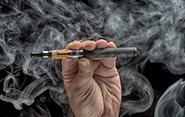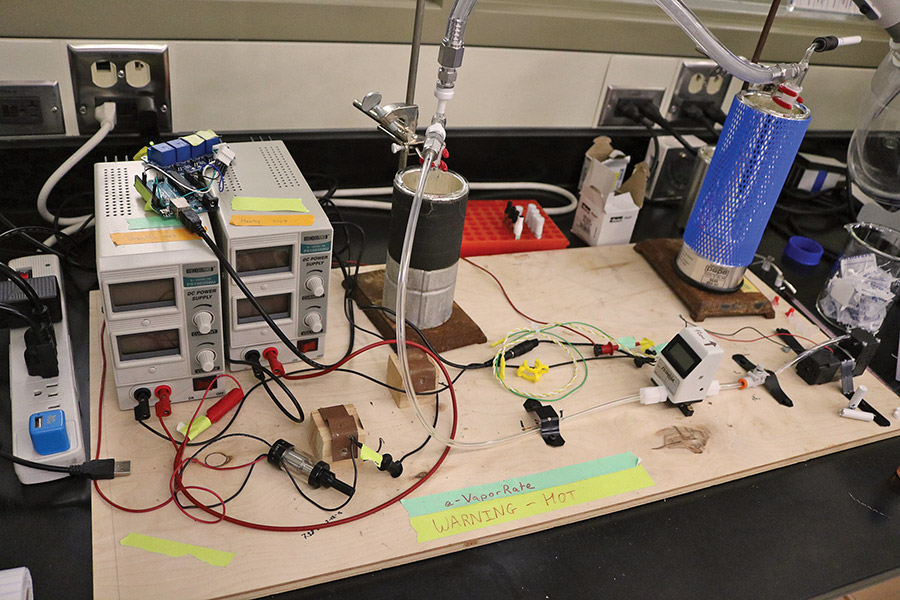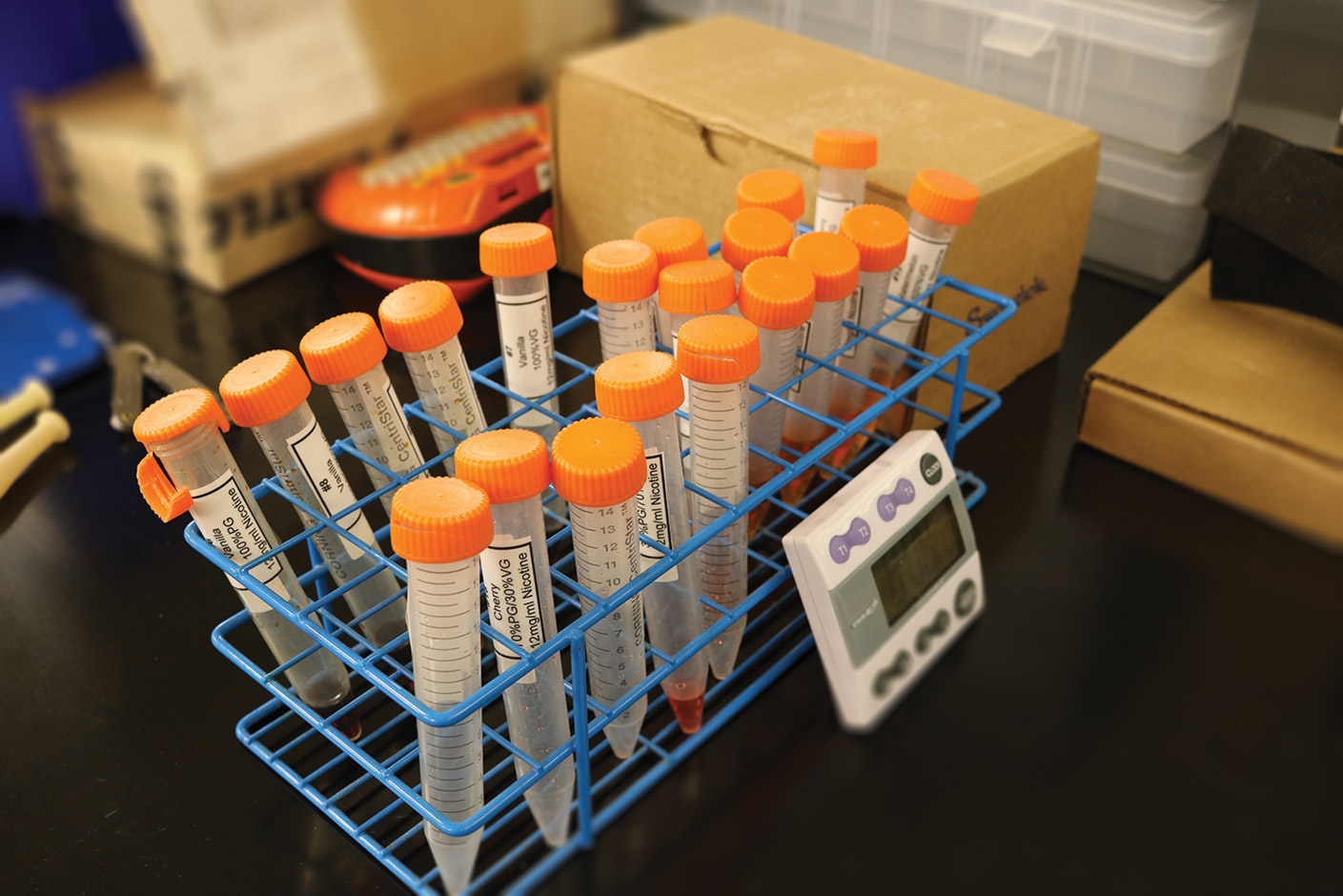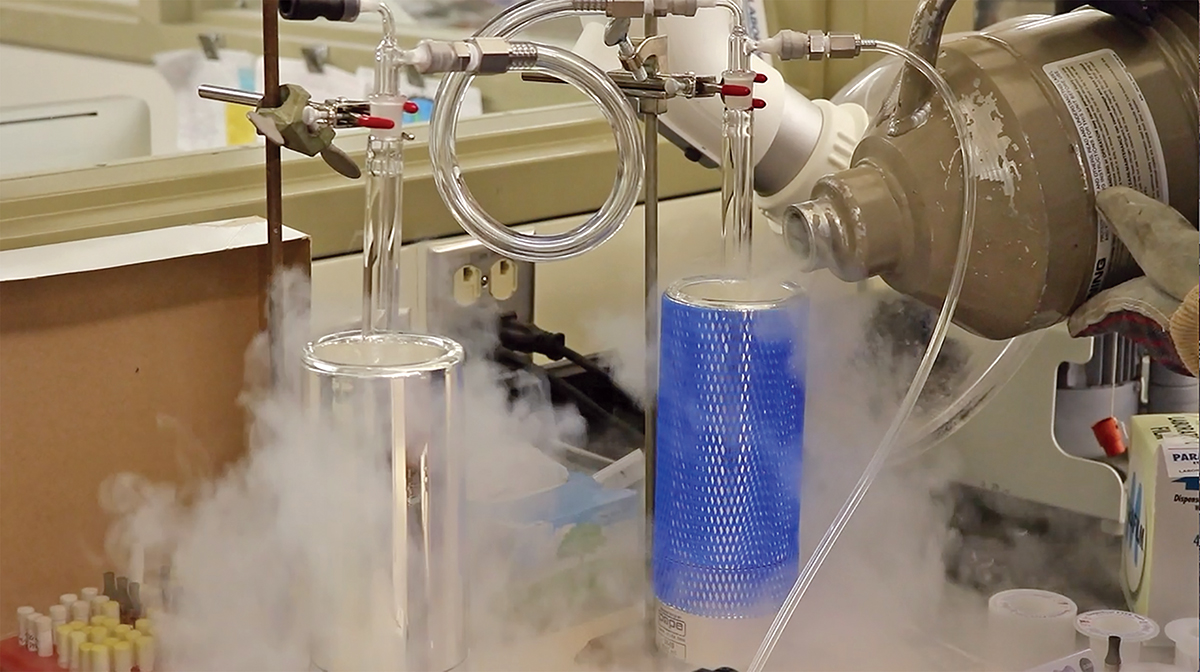Clearing the Fog

This story originally appeared in Yale Engineering magazine.
The popularity of e-cigarettes — battery-powered simulations of actual cigarettes — has increased rapidly since their introduction just over 10 years ago.
Their rise has happened so quickly that science hasn’t kept pace, and the health effects of “vaping” — inhaling vapor with nicotine, flavorings, and other chemicals — are still unclear. Advocates of e-cigarettes note that these devices don’t use tobacco or produce smoke — both of which have been long known to promote cancer. However, very little is known about what happens when the chemicals that make up flavors that go into e-cigarettes’ mixtures (known as e-liquids) are vaporized and inhaled.
 To analyze these chemicals, the research team in the laboratory of Julie Zimmerman has developed a machine that mimics the mechanics of a person using an e-cigarette. The system, known as the E-Vaporator, is designed so the researchers can look at a commercially produced e-liquid or make their own and then put it into an e-cigarette device. The system sucks in the vapor, mimicking a human’s inhalation, and then “exhales” the same vapor that a human would be exposed to when using an e-cigarette. The machine captures that vapor and collects it in liquid nitrogen so that it can be sampled and analyzed.
To analyze these chemicals, the research team in the laboratory of Julie Zimmerman has developed a machine that mimics the mechanics of a person using an e-cigarette. The system, known as the E-Vaporator, is designed so the researchers can look at a commercially produced e-liquid or make their own and then put it into an e-cigarette device. The system sucks in the vapor, mimicking a human’s inhalation, and then “exhales” the same vapor that a human would be exposed to when using an e-cigarette. The machine captures that vapor and collects it in liquid nitrogen so that it can be sampled and analyzed.
Getting a good read on these chemicals and how they change in the process of vaping is particularly important because e-cigarettes have proven popular among young people. The wide variety of available flavors is a big part of the appeal.
“They tend to be very sweet and have fruity flavors, or flavors like gummy bears and piña colada,” said Zimmerman, professor of chemical & environmental engineering and forestry & environmental studies. “So, there’s a concern about addiction to nicotine products and how people become addicted to nicotine through these flavor enhancements.”
Just as science is working to keep pace with e-cigarettes’ popularity, so are governing agencies. The chemicals that make up these flavors are currently unregulated, as the Food and Drug Administration has already approved most of them for candy and other food products.
“The flavor compounds that are added to candy and gum are not different to the ones added to e-cigarettes, necessarily,” Zimmerman said. “It’s the exposure route that’s different. When you eat candy or gum, you ingest it, and now we’re taking flavor compounds and inhaling them. The exposure route from a human health risk is quite different, and we don’t have data on most of these compounds as an inhalation risk, as opposed to an ingestion risk.”
Their research so far shows that the compounds in commercially produced e-liquids are unstable and reactive. When these products are sitting on the shelf, chemical reactions happen between the time they’re manufactured to when they get used. More reactions happen when these liquids are vaporized and inhaled.
“We’ve learned that as these compounds are vaped — heated and oxidized — that there are chemical reactions happening and we have more toxic compounds that are forming,” Zimmerman said, adding that these compounds are more irritating than the ones that were present at the time the e-liquid was produced.
Now they want to know what that means as far as health risks.

“Whether it’s storage of e-liquids or the heating and oxidation during vaping or biological reactions inside the body, we really want to understand the potential risk or toxicity of these compounds,” she said. “We need to look at the dynamic systems in the vapor and what humans are actually being exposed to — not just the product they’re buying on the shelf.”
With the many questions that Zimmerman and her research team had, they needed a way to study these compounds and their effects. The task fell to Mark Falinski, a Ph.D. student in Zimmerman’s Lab, who developed the world’s first E-Vaporator.
“My advisor brought this project up to me and I thought it was great, because I have family members who use e-cigarettes all the time,” Falinski said. They insist to him that it’s healthier than smoking cigarettes, but Falinski tells them the jury is out. “There hasn’t been any definitive proof yet, so I think it’s a good project.”
After a series of brainstorming sessions and some trial and error, Falinksi built a device that, when it’s hooked up with an e-cigarette device, will pump the vapor through tubes, which is then collected in two vessels of liquid nitrogen.
“As the vapor is pulled through the e-cigarette, it gets condensed inside these vessels with the liquid nitrogen, and then they’re covered up and brought over for analysis,” he said. When he switches the device on, it emits a rrrrrrrr sound, which is essentially the sound of the machine’s “lungs” breathing in the vapor.
There are two meters that evaluate the flow rates of the vapor. An Arduino device that they programmed controls when the device turns on and off and how long it’s on. It also helps control the flow rate. The design of the device gives the researchers the flexibility to use it on different e-cigarette devices. So far, much of their research has focused on new-fangled vaping technology. Recently, they’ve begun using the device to study the chemical processes that happen when using a hookah, a smoking device that goes back centuries and is having a resurgence of popularity.
 The E-Vaporator has proven to be a valuable tool in the lab’s collaborations with other researchers, including Barry Green at the John B. Pierce Laboratory and the Yale Tobacco Center of Regulatory Science (TCORS), led by Suchitra Krishnan-Sarin, a professor of psychiatry. In a recent study, the device was used to look at the effects of adding sucralose to the e-liquids. Hanno Erythropel, a Ph.D. student in Zimmerman’s lab who worked on the study, noted that adding the artificial sweetener is a common practice among vapers as a way to enhance the flavors of e-liquids. Although results varied depending on what vaping system was used, they found that the sucralose (a stable, non-volatile compound) didn’t have a huge effect on flavor or the users’ preference. That’s because most of the perceived taste came from the users’ sense of smell, which was more effective at picking up the flavors from the unstable, volatile compounds of the e-liquids.
The E-Vaporator has proven to be a valuable tool in the lab’s collaborations with other researchers, including Barry Green at the John B. Pierce Laboratory and the Yale Tobacco Center of Regulatory Science (TCORS), led by Suchitra Krishnan-Sarin, a professor of psychiatry. In a recent study, the device was used to look at the effects of adding sucralose to the e-liquids. Hanno Erythropel, a Ph.D. student in Zimmerman’s lab who worked on the study, noted that adding the artificial sweetener is a common practice among vapers as a way to enhance the flavors of e-liquids. Although results varied depending on what vaping system was used, they found that the sucralose (a stable, non-volatile compound) didn’t have a huge effect on flavor or the users’ preference. That’s because most of the perceived taste came from the users’ sense of smell, which was more effective at picking up the flavors from the unstable, volatile compounds of the e-liquids.
It’s one more piece of information about vaping, but researchers still have a long way to go. As more flavors are concocted and new ways to inhale them are invented (Juul, a vaping device that looks like a USB drive, is one of the industry’s more recent innovations), Zimmerman’s research team will remain busy. As Erythropel notes, the field of research is wide open.
“No one had ever thought of this idea that you could heat something in a little device with a battery, and then you could inhale it,” he said.

